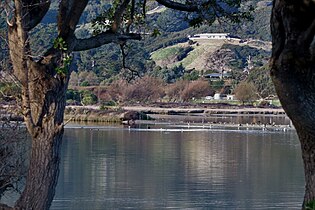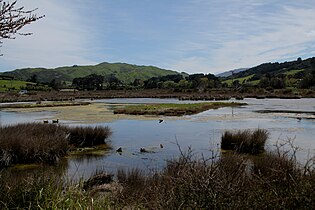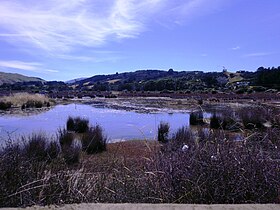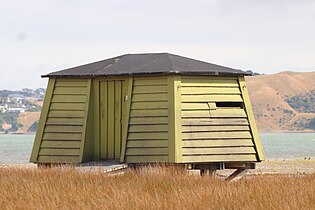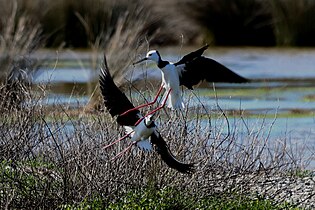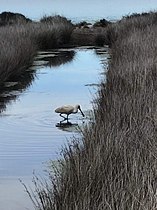41°06′09″S 174°54′52″E / 41.10246°S 174.91436°E / -41.10246; 174.91436
| Pāuatahanui Wildlife Reserve | |
|---|---|
 Royal spoonbills and Pied stilts Royal spoonbills and Pied stilts | |
| Location | Porirua, New Zealand |
| Area | 50 hectares (120 acres) |
| Created | 1984 |
| Operated by | Department of Conservation, Forest & Bird |
Pāuatahanui Wildlife Reserve is a wetland reserve at the eastern edge of the Pāuatahanui Inlet of the Porirua Harbour in Porirua, New Zealand. The reserve contains the most significant area of saltmarsh in the lower North Island of New Zealand. It also includes tidal mudflats, shrub lands and regenerating coastal forest. The reserve covers 50 hectares (120 acres), of which the Department of Conservation owns 46 hectares, and Forest & Bird owns the remaining 4 hectares under covenant to the Queen Elizabeth II Trust. The reserve is managed by a committee of Forest & Bird representatives in association with the Department of Conservation.
History
The area had previously degraded into a wasteland that included a go-kart track, playing fields, demolition spoil, farm land and a cattleyards. Work on restoration began in 1984.
In 1985 the area was made into a Wildlife Management Reserve. This involved the development of ponds, walking tracks and viewing hides. The reserve was officially opened on 15 April 1989.
In 2002 the area of the reserve was extended by 1.8 ha (4.4 acres) through the purchase by the Nature Heritage Fund of land adjoining the banks of the Pauatahanui Stream.
Plants
The habitats in the reserve range from tidal mudflats to coastal forest. The main wetland species are reeds, rushes, harakeke, raupō, glasswort, sea primrose, New Zealand spinach, half-star, and wild celery. The coastal scrub includes coastal tree daisy, marsh ribbonwood, ngaio, taupata, kānuka and mānuka. The rare succulent Thyridia repens is also found.
Birds
Many different native and exotic birds can be found at the Pāuatahanui Wildlife Reserve, including the bar-tailed godwit, royal spoonbill, caspian tern, paradise duck, pied stilt, sacred kingfisher, white-faced heron, Australasian shoveler, pūkeko and black shag.
In the areas of regenerating bush, the birds that can be seen include tūī, grey warblers and fantails.
In April 2017, twenty-two fernbirds were released into the reserve, in a translocation from Lake Rotokare Scenic Reserve in Taranaki. Fernbirds have been seen in the reserve in the following years.
Freshwater fish
The Pāuatahanui stream flows through the wildlife reserve at the south-eastern corner of the inlet. This stream provides habitat for native and threatened fish species including inanga, longfin eel, giant kōkopu, and redfin bully.
Threats to the reserve
There are many threats to the reserve from predators and human activity. Predators that threaten the reserve include stoats and rats, but also domestic cats.
Surveys of cockles in 1992 and 1995 indicated a decline to only one third of the numbers estimated in 1976. Silt and contamination from subdivisions and stormwater drains. Increased runoff of contaminated stormwater from urban expansion and increased dairy farming. Silt from construction works and runoff from the Transmission Gully motorway were considered significant threats to the reserve in a 1996 study of the environmental impact of the planned motorway.
Studies of the seagrass Zostera muelleri in the Pāuatahanui inlet have shown that pollution from fine sediment is preventing seagrass re-establishing in sites where it formerly grew. The results of the study emphasise the critical importance of strategies to reduce the amount of fine sediments from catchment areas that reach estuaries.
In 2011, the wildlife reserve was being polluted by sewage runoff from septic tanks in adjoining properties that were not connected to a trunk sewer. Porirua City Council was investigating connecting these properties to the sewerage system to eliminate the problem.
In 2014, a man was arrested after shooting ducks in the reserve.
Awards
Pāuatahanui Wildlife Reserve was one of three winners of the 2001 New Zealand Wetland Conservation Award, run jointly by Fish & Game New Zealand and the Department of Conservation. The award recognised 17 years of hard work by volunteers.
In the Wellingtonian of the Year awards 2009, Wanda Tate was recognised with the Environment Award, for 17 years work on restoring the Pāuatahanui Wildlife Reserve. Tate also won the Annual National Golden Spade award from Forest and Bird, and a QSM for her work on conservation.
Gallery
References
- ^ "Pauatahanui Wildlife Reserve" (PDF). Department of Conservation. December 2010. Archived (PDF) from the original on 8 October 2021. Retrieved 25 December 2015.
- ^ "Pauatahanui's Special Ecosystems". Forest & Bird. 5 November 2018. Archived from the original on 8 October 2021. Retrieved 8 October 2021.
- Bain, Helen (28 December 2009). "Nature takes back control". Dominion Post. ProQuest 507211701.
- ^ Brooks, David (2017). "Shh... fernbirds are here". Forest & Bird (364): 30–31. Archived from the original on 21 July 2023. Retrieved 21 July 2023 – via National Library of New Zealand.
- "Wildlife reserve". Guardians of the Pāuatahanui Inlet. Archived from the original on 8 October 2021. Retrieved 9 January 2013.
- "Items of Interest – Pauatahanui". poriruacity.com. Archived from the original on 9 February 2013. Retrieved 10 January 2013.
- "Reserve gets bigger". Dominion Post. 27 July 2002. ProQuest 337998288.
- Williams, Jolene (31 December 2011). "Natural Summer; Treasure trove of walks". Dominion Post. ProQuest 914170407.
- "Bringing back a rare little resident Fernbird in new home". Wanganui Chronicle. 26 April 2017. ProQuest 1891529631.
- "Rare birds take flight in wildlife reserve". Greater Wellington. 17 June 2019. Archived from the original on 23 October 2021. Retrieved 14 October 2021.
- "Pauatahanui Stream". Land and Water Aotearoa. Archived from the original on 29 October 2021. Retrieved 14 October 2021.
- "National honour for Pauatahanui reserve". Evening Post. 2 February 2001. ProQuest 314728135.
- Williams, Murray (7 September 1999). "Guardians of the inlet". Dominion. ProQuest 315127695.
- Napp, Bernie (20 May 2002). "Dirty water tops environment report worries". Evening Post. ProQuest 314815030.
- Shelton, Adam (11 March 1996). "Road would endanger wildlife". Dominion. ProQuest 314921360.
- Zabarte-Maeztu, I.; Matheson, F.E.; Manley-Harris, M; Davies-Colley, R.; Oliver, M.; Hawes, I. (2020). "Effects of Fine Sediment on Seagrass Meadows: A Case Study of Zostera muelleri in Pāuatahanui Inlet, New Zealand". Journal of marine science and engineering. 8 (9). doi:10.3390/JMSE8090645. ISSN 2077-1312. Wikidata Q120768908.
- Torrie, Bronwyn (20 June 2011). "Something rotten in state of Pauatahanui Wildlife Reserve". Dominion Post. ProQuest 872508767.
- "Man duck shooting in wildlife reserve". NZ Newswire. 25 May 2014. ProQuest 152815648.
- "National honour for Pauatahanui reserve". Evening Post. 2 February 2001. ProQuest 314728135.
- "Honoured for conservation – again". Dominion Post. 5 June 2009. ProQuest 338365266.
- Newton, Kate (27 November 2009). "Taste of success for Logan Brown duo". Stuff. Archived from the original on 29 October 2021. Retrieved 14 October 2021.
- "Investitures ceremonies at Wellington's Premier House". Office of the Governor-General. 31 August 2009. Archived from the original on 26 October 2021. Retrieved 14 October 2021.
